7 essential garden tools to make your gardening life really easy
Invest in good quality versions of the 7 essential garden tools. Then build up more useful tools gradually as you find you need them.
The 7 essential garden tools
- a spade
- a digging fork,
- a rake,
- a hoe,
- a hand trowel,
- a hand fork
- a good pair of secateurs
This post features the tools I’ve used for many years. You can click through to buy them via Amazon, which is an affiliate link (see disclosure). If you buy, I may get a small fee, but it won’t affect the price you pay. And I only feature products I use myself.
At the end of this post are some extra tools that I’ve also found useful.
And if you haven’t had a good tool sort-out recently, now is the time to winkle trowels out of trugs, scrabble in the backs of shelves for secateurs, rootle around in the potting shed for hand forks and search all your nooks and crannies for stray gardening gloves.
They need their annual clean-up. And it’s time to chuck those bent forks and dinky little painted trowels. Get yourself a set of garden tools that really work.
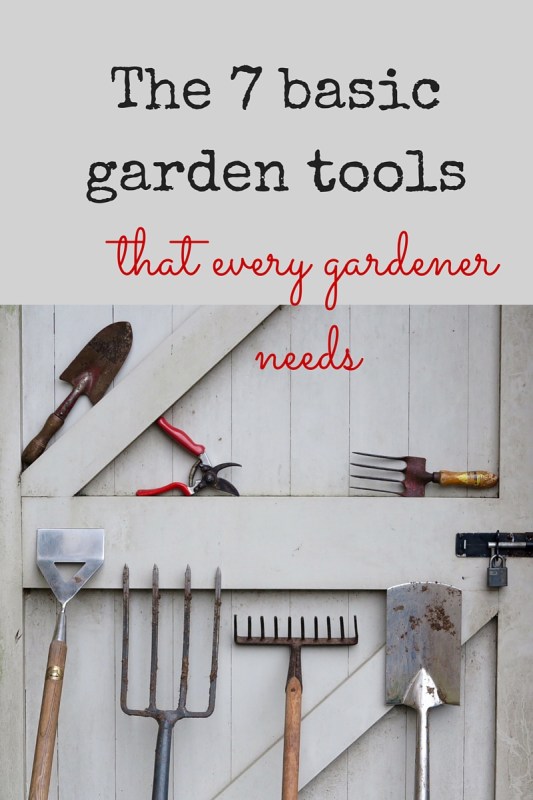
You don’t have to buy lots of tools – buy a few, but spend your money on quality…
Options for essential garden tools
Within these seven essential garden tools, there are options. Many gardeners have several sizes of each, but that’s probably not always necessary if you have a middle-sized garden. And if you have a professional gardener, they usually bring their own tools. Find out more about finding the perfect gardener for your garden here.
Start by buying tools that suit your height and strength. Then you can add to the collection as you learn more.
I have a smaller, more lightweight spade because full size spades give me backache. The one I use is called the Kent & Stowe Garden Life Spade. It’s also a useful spade for digging up a plant in a confined area, such as a packed border. There is also a lightweight digging fork in the same Kent & Stowe Garden Life range.
Lightweight spades and forks are much easier to use, but they don’t last as long. Returning to this post in 2023, five years after I originally wrote it, I can report that my lightweight garden spade and fork lasted around 8 years before breaking. But it was eight years of comfortable gardening! So that’s the choice you have to make.
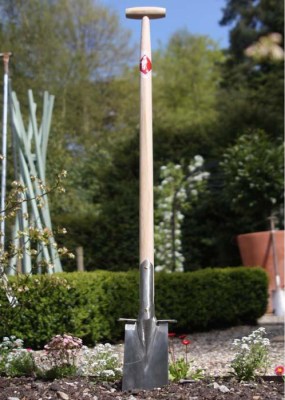
A Ladies Spade from Harrod Horticultural.
If you have a smaller or courtyard garden, then your list may be a little different. In this post, asked Dan of Dan Cooper Garden to list the most useful garden tools for his courtyard garden. I was quite surprised at one or two of his recommendations.
Pruning tools
When it comes to secateurs, don’t buy the cheapest. I bought a pair of Felco secateurs over 30 years ago. And I still use them. Other cheaper secateurs have driven me mad – their springs go, their handles loosen…
And if you’re doing all your pruning yourself, you will need a pair of loppers and some good shears.
I was sent a pair of Wilkinson UltraLight Bypass Loppers to review. They really are light and cut well (see my review of new gardening supplies)
The best shears I’ve ever handled are my Niwaki shears. They cost from around £70, they’re not cheap but so easy to use. Spending so much on them makes me treat them reverently – I certainly don’t leave these sprawled on a damp lawn just because I’ve had to rush in to answer the phone.
For tips on pruning, find out the absolutely best way to prune lavender, and how to prune trees for privacy and light.
And do visit Great Dixter one day. I visited in February, when pruning is key to creating the wonderful borders later on in the year. Pruning is at the heart of why it’s such a wonderful garden – you can improve your pruning with 10 Great Dixter pruning tips they told me about.
So what else is worth buying?
If you want to expand on your gardening basics, then see my post on The Best Garden Supplies for three great weeders.
A pruning saw (£35-£159) is then the next choice – but if you get someone to help you with your pruning ( I do), then they will bring their own tools.
The biggest mistake when choosing essential garden tools?
The biggest mistake is to choose the cheapest tools. The saying “buy cheap and buy twice” is very relevant for garden tools.
Ten years ago, we were given a Snoeber Long Thin Trowel as a present from a friend. It is as solid and sparkling as it was the day it arrived, in spite of complete neglect from me.
The same cannot be said for a succession of useless hand trowels and forks, from various gift shops and supermarkets – or given away as freebies by garden companies that don’t make tools.And it’s not just irritating when a hand fork snaps – you can hurt yourself.
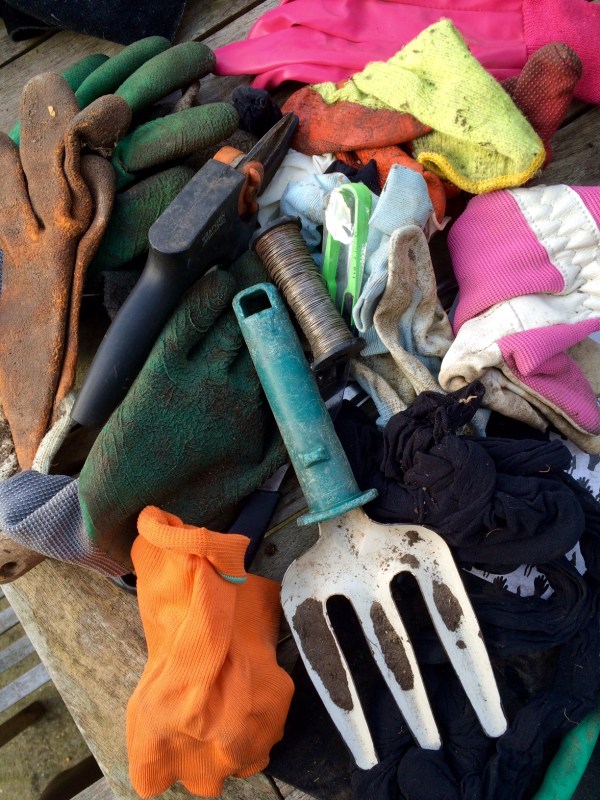
Does your tool trug or shelf look like this? Note the hollow tines of the cheap hand fork…
How do you spot a poor quality tool?
A tool that is painted rather than one which is plain metal is probably going to be of poorer quality. Paint covers up cheap wood and metal. Paint will flake away quickly and the metal beneath will rust. And if the wood and metal is cheap, then the tools themselves are more likely to bend or break.
Personally, I think any garden tool with flowers painted on it is probably just gift shop fodder. The exception is the RHS Burgon & Ball range of tools, which are both beautiful and practical. I have several sets of the hand fork and trowel. One set was given to me for review by the RHS and another set was a Christmas present from a friend I use them constantly.
And price is a clue. Good work costs money. You don’t have to buy lots of tools, just a few good ones.
And there are creative solutions: if you want to get really good quality loppers, for example, you probably won’t be using them every weekend, so why not share a pair with a friend?
What about vintage tools?
I live in the historic market town of Faversham. We have markets every Saturday, plus a vintage & antiques market on the first Sunday of every month. And there are lots of vintage/second-hand/charity shops, too, including a vintage tool shop, down on the ancient Faversham Harbour.
I also enjoy going to car boot fairs, where there can be some really excellent vintage tool finds. However, prices are going up, as vintage tools are becoming fashionable (although I think they are often used as ornaments now, or as accessories for styling).
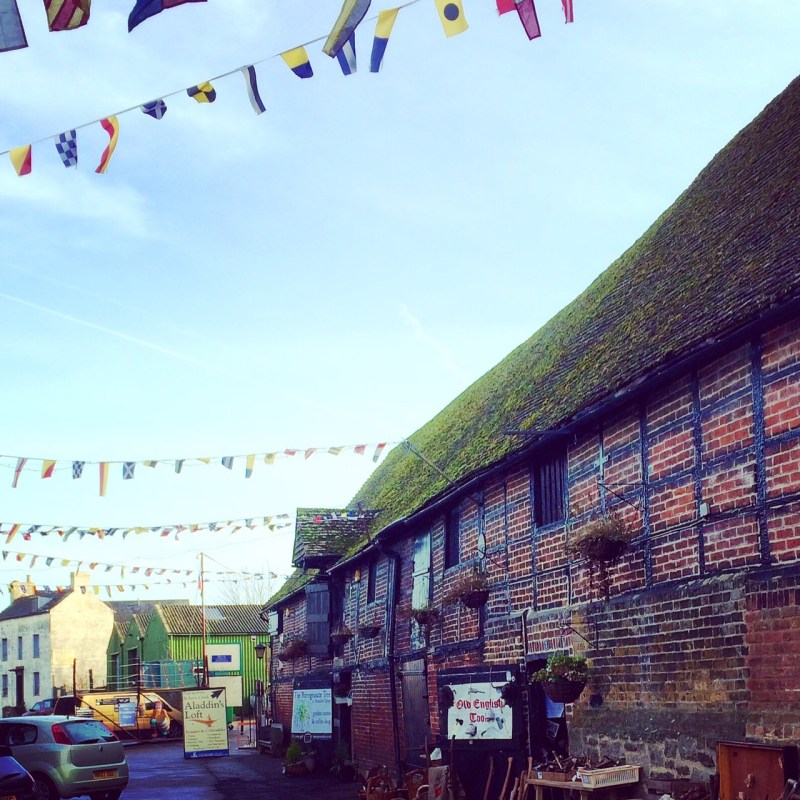
The vintage tool shop in Faversham is down at the Harbour, in one of the oldest working warehouses in Britain. Most of the tools are workshop-y rather than gardening, but I got a hand fork and trowel, plus a hand rake for £13 the lot. They do seem stoutly-made, although are a little heavier than well-made tools nowadays.
Vintage tools look lovely, they are solidly-made and they can be a way of getting good quality tools for less.
However, they’re often a bit heavier than many good tools made today, so see how they feel when you hold them in your hand and lift them. Car boot and yard sales could also be a good place to find second-hand tools.
Proper care makes essential garden tools last longer
Once you’ve bought your essential garden tools, you need to look after them. They will often last for decades if you do.
Brush dirt or garden debris off my tools after use with a stiff brush. A quick wipe with an oily cloth prolongs the life and performance of your tools and saves you from a big tool cleaning job over winter.
I have asked Mr Middlesize if we have any oily cloths, and he has donated an old cotton shirt to the cause. And you can use linseed oil, which you can usually get from hardware stores.
Service your secateurs
Secateurs are another thing that appear in gift sets for gardeners, but there’s nothing more uncomfortable than using a badly-made pair of secateurs.
Secateurs are one of the seven essential garden tools, but cheap ones can tear stems and damage plants.
If you have good secateurs, like Felco or Niwaki, it’s really worth looking after them. If you have Felco secateurs, you can send them away to be serviced for £19.99 (includes return postage). Felco also have spare parts, if the secateurs break, plus lots of information about sharpening and oiling secateurs, which would be useful whatever brand you have.
And the all-purpose tool
At the other end of the spectrum you have the all-purpose tool, which many gardeners swear by. Fern Alder of Full Frontal (a national community garden initiative to green up front gardens) uses the Kirpi from The Organic Gardening Catalogue (£18.95, pictured below).
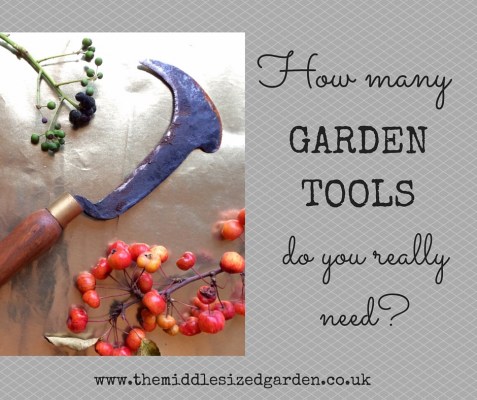
Does an all-purpose garden tool save you buying all the others? Not quite but you can do alot with it.
Back to the middle-sized tool trug
The clear-out has yielded six matching pairs of gardening gloves (a real bonus!), which I put through the washer at 30 degrees. I made myself throw away several lonesome gloves whose partners had deserted them.
Today, I will clean and sharpen everything, ready for spring. Have I left out any of your essential garden tools? Do leave a comment here, or on Facebook or Twitter. And if you make high quality garden tools painted with flowers, do feel free to leave an enraged comment…thank you!
Shop my favourite garden tools, books and products
I’m often asked for recommendations so I have put together some useful lists of the garden tools, books and products I use myself on the Middlesized Garden Amazon store. As well as a list of essential garden tools, I’ve also got a list of other useful gardening products, such as good gardening gloves, kneelers and knee pads.
Pin to remember essential garden tools
And do join us every Sunday morning for more gardening tips, ideas and inspiration. Click here to follow by email.
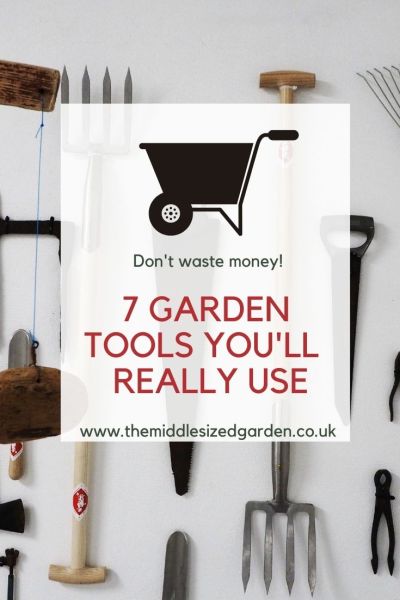

The Middlesized Garden is a participant in the Amazon Associates LLC, an affiliate advertising programme designed to provide a means for sites to earn advertising fees by advertising and linking to Amazon.co.uk























Excellent advice. I was buy few cheap product from my local market which was very poor quality. Can you suggest me any low budget idea?
People do occasionally say they’ve had good experiences with a particular tool from a supermarket, but I think this may be when supermarkets get a good tool company to manufacture a special batch for them. I’m not aware of any cheap tools that are consistently good.
You shared an excellent list for garden tools but I am wondering that you didn’t pot garden hose in this list, What do you think about it?
Hoses are useful but are not strictly speaking ‘tools.’
I really like this writeup, even I’m still finding my hose nozzle one of the best tools I use on a daily basis to maintain my yard.
Take care!
Thank you. Thought I should add that I’m deleting commercial links on most comments as it was being misused.
Good post for gardening lovers. I learn something totally new and challenging on sites
I StumbleUpon every day. It will always be useful to
read articles from other writers and practice a little something from other web
sites. Thanks for this article as it is very helpful for the old agers.
Great list. If I had to pick one it would be secateurs, I use mine every day.
Absolutely
Great call on pruning tools, thanks for sharing!
Thank you.
The Felco Secateurs are a great buy. I used them to shape up a small bush in my back garden where I could take some time to decide which shape I wanted. The Secateurs were so easy to use too as have had similar products in the past where you need to exert a lot of effort to cut with.
I think one important point about any tools is always buy the best that you can afford, they will last longer. That goes for your gloves as well.
Very true!
For high pruning of tall trees and shrubs I can highly recommend the Darlac Expert saw and anvil pruner. The two items are swappable with different length poles – although I’d only recommend the 4.9mtr pole if you really need the height – the 3m pole is heavy enough to use, the 4.9mtr pole needs a lot of strength to lift and use. Having used cheaper versions that lasted a couple of seasons at best, I’ve been delighted with this set up, and the saw with optional handle will saw through logs better than most bow saws.
Obviously check whether you’re in a conservation area or whether a tree preservation order limits what you can do, and equally importantly if in doubt as to your abilities call in a tree surgeon!
Very good advice – it is particularly important not to try to cut very high branches unless you know what you’re doing. Interesting to hear about the Darlac, thank you.
Great article, but I don’t understand why the bucket was not included in a list as it’s very handy multipurpose tool. From my point of view it can be more useful then tools listed above:
– put weeds in the bucket and then take it to the compost.
– Load it up with dirt / mulch / rocks to transport to a place a wheel barrow won’t reach.
– Turn it over and sit on it (thx Peter)
– if you don’t have a watering can, or if you want to know the exact amount you are watering
– also you can put your garden tools and carry them around yard with you
But I prefer the metal bucket over the plastic, better if it is bright coloured bucket http://apromera.com/
I absolutely agree – I hadn’t considered a bucket to be a tool rather a useful piece of equipment (is there a difference?). Really good list of things to do with a bucket!
Great write-up!
But for me, I found a wheelbarrow to be a must for my garden along with these tools!
You just can’t skip that! ;)
I wear latex gloves underneath normal gardening gloves. Double benefit – they keep you extra warm and dry in winter (i garden in the north of scotland so this is of prime importance!), help prevent mucky hands / nails, and you can whip off the heavier gardening gloves to do a finer/ less mucky job (or answer the phone or whatever!) and still have hands (or your phone) protected.
I so agree! I shall add a box of Latex gloves to the list. I couldn’t garden without them, thank you for reminding me.
Great Article.
I can just confirm that It’s not worth buying the cheapest tools out there.
I´ve been buying a lot of gardening tools and, yeah.. Cheap ones does not last.
– William
Thank you for agreeing with me!
I agree with the pruning saw and have one in my gardening kit bag. The item that I would be lost without though is the sharpener for my secateurs. It also lives in my kit bag so that I can sharpen as I prune (and again when I clean and oil my secateurs after use) – and a quick mention for my copper trowel, a beautiful tool to use! (Even if the debate is still open as to whether it helps in preventing slugs.)
The copper trowel sounds beautiful. But, as for slugs – a friend sent me a photo of a piece of copper she left out in her garden (I’m not sure what it was). A few weeks later there were actually about a dozen snails sheltering on/under it…so I haven’t been convinced as to the copper/snails argument for a while!
I’d add a pruning saw (I think I use this more often than loppers). I also like my little hand hoe (aka onion hoe) for small areas like raised beds.. I’ve not seen the hand rake before but that looks like a useful tool.
Thank you – yes, I had been wondering whether a pruning saw might be one of the essentials. I don’t personally use one, but I’m thinking of putting it on the shopping list.
If there is back breaking ground breaking to be done there is no substitute for the digging hoe used widely in Africa and Americas. Very effective and the “physics” is better than the spade. They are very cheap at a well known online bookshop.
Interesting! I have just looked it up on the ‘well known online bookshop’ and it certainly looks quite different from anything we British gardeners use. Thanks for letting me know.
Absolutely brilliant – gorgeous photography. I would add to the good secateurs and gloves – GOOD gloves. I was given a pair of soft, waterproof, comfy gloves (brand forgotten) for Christmas – and they are heavenly. A blog in itself!
Oh, yes, definitely good gloves. I really like Showa, and also use latex surgical gloves for lightweight work, although they shred when faced with anything even remotely thorny.